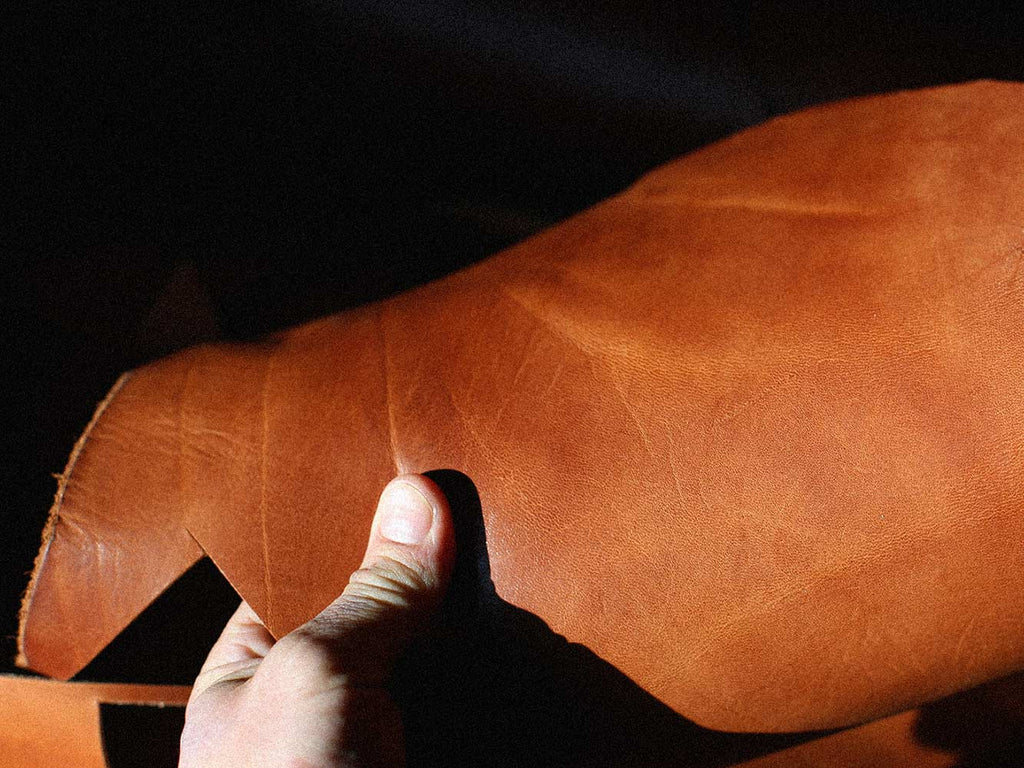Types of leather and Tanning process
Vegetable Tanned Leather brings a certain nostalgia to me when I think of the traces it leaves over time. How many times did I fall upon one of my grandpa’s leather bags imagining all the roads it might have traveled. I think beauty comes with time, just like a good wine. Rigid at its natural state, leather breaks, softens, and takes on a patina; giving it character and bringing out its natural beauty.

When I receive a new leather lot from the tannery, I often take time to look at the rawness of the material, the unique marks of each hide. Leather is alive after all, and I have a lot of respect for its imperfections and the way they inhabit the material. Mosquito bites, getting stuck in a barbed wire fence, we can almost imagine the cattle in its field and pay homage to the life it lived.


Vegetable Tanning: great recipes and patience
Don’t be mistaken, the leather used for Vegetable Tanning comes from an animal. Achieved with plant based tanning agents like tree barks, leaves, or even roots ou encore de racines, this tanning method is the oldest we know. Way before Europeans did, here, First Nations tanned the hunted game hides they used to make hard goods. First, hides are cleaned from impurities and then dried to preserve the material and allow for a better absorption of tanning agents. The selection of tanning agents is specific to a tanner or the traditional - and sometimes secret - recipe of a company. The hides are then soaked in huge barrels for a moment’s rest (between 30 and 60 days). Magic happens, and the result: a natural product of quality that is solid and durable, free of allergens and in harmony with the environment (biodegradable). With time, Vegetable Tanning evolves and patina slowly sees the day.



Oak aged barrels. Photo courtesy of Wickett & Craig.
Mineral Tanning: large scale production
Mineral Tanning is the most common method used in the industrial realm and is achieved with minerals like chromium salts. It is efficient and it was discovered and used mostly in the shoe manufacturing industry in the thirties. Bright colored leather can only be obtained through this tanning method which makes for a soft and durable material, but produces a large quantity of chemical waste that will be rejected in the water at the end of the production cycle. Unfortunately, mineral tanning is often outsourced in developing countries where the environmental laws are a little less present and it contributes to large-scale pollution in these localities.
Vegan “leather”
Popularized over the last decade, this material is made of plastic or organic matter like pineapple, but more often than not, plastic. Motivated by ethical values and animal respect, businesses will sometimes opt for recycled plastic, sometimes not. However, we must not forget durability. Plastic will most likely decay with time and end up in our soils. It will then become just another piece of trash. Leather forms a whole with the animal and the term should technically never be used for another material than a hide. Leather is leather, organic matter is organic matter, and plastic will always be plastic. There is then no such thing as vegan leather.
----
Nowadays, there is no magic solution to buy an object that has absolutely no environmental impact, and what stays is the energy it took to craft it and its durability. When optimizing processes, we must think of what it means in the long run ; we think there is something rich in the process behind making an object and knowing it comes from meticulous and thoughtful work. That's one of the main reasons why at Robinson we choose Veg-tan over and over again.

